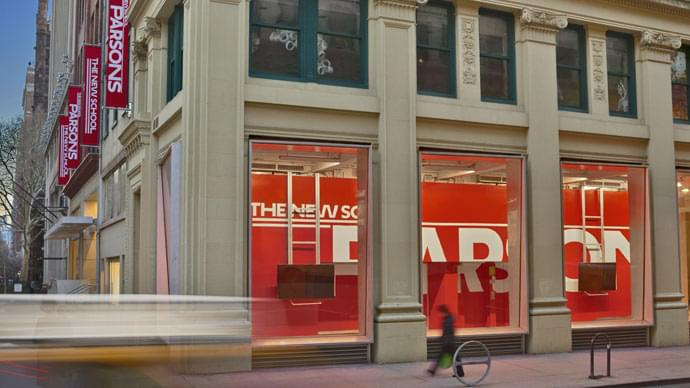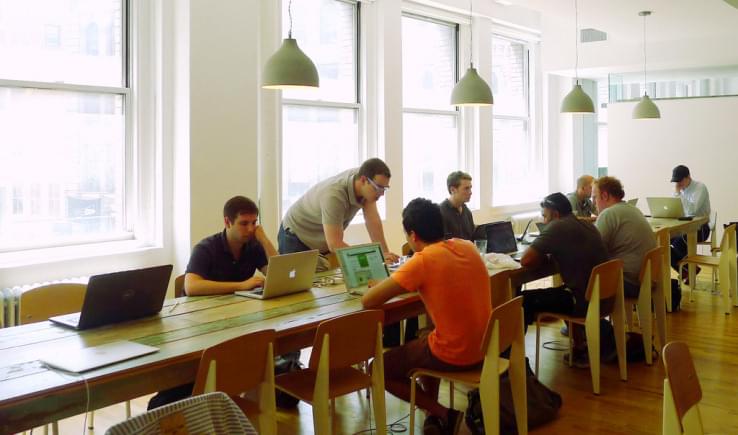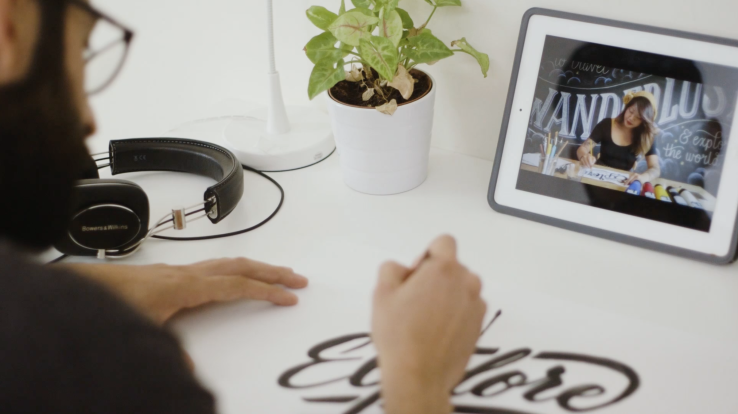
In 1919, modern design education leapt into the public consciousness as the Bauhaus school was unveiled in Germany. Bauhaus was a design school whose primary intention was to bring all fields of art together.
Compared to the way design had been previously taught, Bauhaus focused on the concept of modernism, which emphasized simplified forms, rationality, functionality, and the idea that mass production and industry could be reconciled with artistic sensibilities. Around the same time, the Parsons School of Design was being built in New York City by Frank Parsons, who believed that art and design would soon become deeply connected to the evolution of modern business and industry. The curriculum he built was similarly focused on teaching students the fundamentals of modern design.
Throughout the 20th century, hundreds of design universities spread across the globe, spurred on by the early successes of Parsons and Bauhaus. However, design education was nevertheless still reserved to people who were able to afford to attend an institution. Fortunately, this is no longer the case. The proliferation of the internet has democratized the process of becoming a creative professional like never before. The traditional methods of learning design (e.g. going to a university) still exist, but so do hundreds of other incredible tools, both online and offline. With the proper combination of determination, discipline, and time, practically anyone can learn the skills needed to become a designer.

But with so many options available just a few mouse clicks away, how do you decide which option is the best fit for you? And how do you ensure you’re getting the feedback and critique you need to properly build up your skills (since studies show that 1-on-1 teaching throughout your education can significantly improve your ability to improve quickly)?
We know that the options can feel overwhelming, so we’ve put together a list of the best ways to learn design depending on your personality, budget, lifestyle, and personal goals. And if you ever want to chat with an experienced designer as you embark on your creative education, check out this article that provides some tips for finding a design mentor.
If You Prefer a Formal Education in a Traditional Classroom

If you have the budget and time, a formal education at an accredited design school is still one of the best ways to become a designer. Not only will you spend years learning the fundamentals and practicing with modern design tools, you’ll also be constantly surrounded by students just as passionate as you and teachers with decades of experience in a number of industries.
Check out a list of the best design schools in the world here and here, and the best schools in the US here.
Upsides
- You’ll spend years learning the fundamentals at a design college. This can really help to set you apart when you’re looking for jobs and expanding your technical abilities.
- Being surrounded by hundreds of people always trying to do their best work and teachers who live and breathe design education.
- Many top design schools pride themselves on constantly updating their curriculum to keep up with modern design trends.
- An incredible alumni community and career services department that will help you find a job upon graduating.
Downsides
- Slow. If you’re hoping to become a designer as quickly as possible, design school likely isn’t the best option for you, since most schools take at least 3 years to complete. Some colleges have expedited programs but those will still take at least a year.
- Expensive. Most traditional design schools will set you back at least $100k.
- Fairly inflexible curriculum. After choosing a major you have more choice in what classes you take, but you’ll still be required to take a ton of core classes first.
Perfect for anyone who:
- Learns best in small classroom settings and likes to have someone to hold them accountable
- Thrives when surrounded by other people trying to accomplish the same things as them
- Has a high budget (design school can cost well north of $100k over several years)
- Has the flexibility to quit their job and not work for several years (or just work part time)
If You Want to Become a Designer ASAP

If you’re working a job you don’t like and are looking to move to a more fulfilling career as quickly as possible, a bootcamp might be the best bet for you. Bootcamps come in many shapes and sizes. Some take place in-person and others take place entirely online. They generally include 40+ hours of weekly classroom instruction, as well as frequent group assignments, 1-1 sessions with an assigned mentor, and great job placement opportunities. In terms of payment, many bootcamps allow you to pay upfront — or take the course for free, if you agree to pay them a fixed percentage of the salary from your first post-bootcamp job!
In-person bootcamps are generally preferable to online bootcamps, since there are a ton of intangible benefits to being in the same space as your teachers and classmates. Some of the best reviewed in-person bootcamps are General Assembly and Shillington.
If you prefer to learn online, there are also a ton of great options. Schools like Bloc and Springboard are paving the way when it comes to online bootcamps. You can find a full list of bootcamps here.
Upsides
- Extensive job placement opportunities. Bootcamps are designed explicitly for people trying to find jobs quickly, so that’s where their biggest focus lies. After graduating, most bootcamps hold job fairs with lots of companies in attendance (mostly in the tech world).
- Being surrounded by lots of other hyper-motivated people just like you. During most bootcamps, you’ll work on group projects with your classmates and be paired with mentors to give you feedback and critique.
- Speed. Bootcamps pack an entire design education in to 3 months. They’re hard work but you can bet you’ll come out on the other end with more knowledge than you thought possible in such a short time frame.
- Curriculum that is built around the most modern and up-to-date design theories and tools, with a focus on preparing you for the job market.
Downsides
- Still fairly expensive. While much cheaper than a traditional school, a bootcamp can still run you $10-15k over 3 months
- Not a flexible curriculum. Bootcamps are intended to teach you the basics and make you proficient as quickly as possible, so they adhere to a single curriculum for everyone. So if you’ve already spent several months taking online courses in the subject you’re trying to pursue, you might find yourself bored for the first month or two of the bootcamp.
- You have to keep learning after the bootcamp finishes. Three months isn’t a lot of time and many employers will want to see that you have not just completed a bootcamp but have also actively continued to learn and build your portfolio afterwards.
Perfect for anyone who:
- Has the flexibility to quit their job to dive head first into their design education.
- Prefers learning in small classroom settings with lots of 1-1 interaction between teachers and students.
- Is interested in entering the tech industry. Most of the jobs available after a bootcamp will come from tech companies who see the value in hiring motivated newcomers, even if they haven’t spent years in the field.
- Anyone who likes learning in intense, fast-paced environments. Bootcamps will push you to your limits, since they usually include 50+ hours of classroom learning per week and go on for ~13 weeks nonstop. Be ready to work hard.
If You Want a Structured Curriculum But Prefer to Learn Part Time

Quitting your job to attend a bootcamp or full-time university isn’t a realistic option for most people. Luckily, there are a wide array of options that cater to people who prefer to learn at their own pace and don’t have a massive budget to spend on a design education. These options still let you work through a structured course with a curriculum built for those trying to build careers in the design field, and many of them even feature 1-1 components. The cost for these lighter-weight courses ranges from $20-300 per month.
If you want a course that pairs curriculum with mentorship, there are a few great options. General Assembly doesn’t just offer full-time bootcamps — they also have courses for those looking to learn design on their own schedule. Skillcrush is another awesome resource for anyone looking for a part-time education, and Thinkful also has their own part time design program for people looking to learn at their own pace.
On the other hand, if you prefer a totally self-paced course with no mentorship aspect, Treehouse and Skillshare have hundreds of courses covering every aspect of the design world, from design fundamentals to freelancing. Since mentorship is very important as you learn design, you can also set up periodic mentor chats with online design mentors on different platforms if you go the self-guided route.
Upsides
- Affordable! If you don’t want to spend a small fortune becoming a designer, you’re in luck. These courses generally run between $20-300 per month.
- Work at your own pace. Not everyone likes learning in a structured classroom. These courses allow you to enjoy the benefits of structured curriculum while moving at your own pace and spending as much time as you need to master the skills.
- Flexible. While the basic curriculum is fixed for many of these part time courses, you can easily supplement your education by taking as many different part time courses as you want from a number of different services without breaking the bank.
Downsides
- Less of a focus on mentorship. Some of the pricier self-paced courses let you chat with a mentor periodically, but you won’t have as much constant access to mentors and teachers as you would during a full-time bootcamp.
- If you need to work directly with other students to stay motivated, you’d best consider another educational path.
- No inherent job placement opportunities. If you go down this route, you’ll be on your own when it comes to finding a job. There are a ton of great job placement services for people trying to break into new industries.
Perfect for people who:
- Don’t like traditional classroom settings.
- Prefer to move at their own pace and learn on their own.
- Want to keep their current job while learning to become a designer on the side.
- Don’t have tens of thousands of dollars to spend but still want a quality education!
If You Prefer to Build Your Own Curriculum
Finally, we’ve come to the wild west of online education! If you’re the type of person who has very specific goals and doesn’t want to waste any time learning unnecessary skills to achieve those goals, this is the option for you. There are thousands of sites, resources, and platforms online designed to empower the true self-learner, and they come in all forms (from videos, to books, to articles, to podcasts). They’re also, for the most part, free!
MOOCs (or ‘massive open online courses’) like Coursera have paved the way for affordable education online. These services take real university courses and rebuild them in an online environment. By taking these courses, you will be receiving almost the same education as people enrolled at universities (although without the 1-1 benefits of being in the classroom). MOOCs like EdX have a massive number of Design courses to help you learn the basics and then start to master the technical skills you’ll need in the job market.
Skillshare and Udemy are two of our favorite marketplaces for online courses. SitePoint Premium provides unlimited courses, screencasts, and books on design and other topics to anyone with a membership. Anyone can create a course on these platforms, but their teams monitor submissions to ensure quality. You can also read reviews from thousands of students who have already taken these courses to ensure you’re making the right picks. YouTube is perhaps the most extensive repository of design resources available anywhere, and it’s free! Thousands of amazing teachers on YouTube produce millions of videos to teach design skills. Check out this list for some suggestions on great design channels to follow. And finally, there are thousands of other resources to teach yourself design skills, from blogs to individual online learning sites to podcasts. If you’re a skilled Googler, the skills you can learn are only limited by your imagination.
Upsides
- Completely flexible and unstructured. Since you’ll only be consuming content that relates to your specific goals, you can build any curriculum you want across any number of resources.
- Free (or cheap)! Most of these services are completely free, and even the paid ones like Skillshare usually max out at around $10 per month.
- Diverse. By leveraging resources across multiple sites, you can be sure that you’ll be learning design thinking from people with a ton of varied viewpoints. Unlike in a traditional school where you’re likely to learn from people with similar backgrounds, learning by yourself online means that you’re going to be learning from people of various geographic, social, and philosophical backgrounds.
Downsides
- No personalization. Like we mentioned earlier, having an experienced designer to talk to while learning design skills is crucial. If you decide to go this self-guided route, we’d suggest chatting with a mentor periodically to get feedback and direction. Check out this article for suggestions on finding a mentor.
- No job placement opportunities. Again, you’ll be on your own here. But remember that there are thousands of job boards online for designers.
- No direction. Curriculum created by an experienced designer certainly has its benefits, so if you decide to learn by yourself, be sure to do a ton of online research to find out what skills you actually need to learn to be competitive when you’re looking for a job.
Perfect for people who:
Want to learn design in a completely unstructured and cheap way. If you have specific goals and now that building your own curriculum is the best way to achieve those goals, this is the path for you.
Thrive when holding themselves accountable. If you’re great at setting deadlines and sticking to goals, you shouldn’t have much trouble learning this way.
Can’t afford to quit their job or spend significant chunks of time learning via traditional courses
Compared to the early 1900s, the number of ways that you can build your design skills today is staggering. No matter what your personality, budget, or learning preferences, there’s an option out there that is perfect for you. Before you decide your preferred learning path, we recommend mapping out a few things first:
Your ideal educational budget + timeline
Your ultimate goal (e.g. get a job quickly, become a freelancer, learn design as a hobby)
How important an in-person aspect is to you during your education
How important 1-1 interaction with a teacher is
After you have those questions answered, everything else should fall into place. So get out there and start turning your creative dreams into a reality! And remember, if you’re looking to chat with a mentor at any point (either when you’re deciding which educational path to go down, or during your creative education), check out the community of online creative mentors on RookieUp, where you can set up quick chats with creative professionals who can help you crush any goals you have!
Frequently Asked Questions about Design Education
What are the different types of design education available?
There are several types of design education available, each catering to different interests and career goals. These include graphic design, industrial design, interior design, fashion design, and more. Each of these disciplines has its own unique set of skills and techniques. For instance, graphic design focuses on visual communication and problem-solving using typography, photography, and illustration, while industrial design is more about the process of designing products that are to be manufactured through techniques of mass production.
How important is a formal design education?
A formal design education can provide a structured learning environment, access to experienced instructors, and opportunities for networking and internships. However, it’s not the only path to a successful design career. Many successful designers are self-taught or have learned through online courses and tutorials. The key is to continually learn, practice, and apply design principles in real-world projects.
What are the benefits of online design education?
Online design education offers flexibility, affordability, and accessibility. It allows you to learn at your own pace, from anywhere in the world. Many online courses also offer interactive elements, such as forums and live chats, where you can interact with instructors and fellow students. However, it requires self-discipline and motivation to stay on track.
What is the role of design education in the future of design?
Design education plays a crucial role in preparing designers for the future. It equips them with the necessary skills and knowledge to tackle complex design challenges and create innovative solutions. As technology and societal needs evolve, design education must also adapt to ensure that designers are ready to meet these changes.
How does design education impact society?
Design education has a significant impact on society. It equips individuals with the skills to create products, services, and systems that improve people’s lives and the environment. Designers can influence how we interact with the world, from the products we use every day to the way we navigate our cities.
What skills do I need to succeed in design education?
To succeed in design education, you need a mix of technical and soft skills. Technical skills include proficiency in design software, understanding of design principles, and ability to create visual elements. Soft skills include creativity, problem-solving, communication, and teamwork. A passion for learning and staying updated with the latest design trends is also crucial.
Can I pursue design education while working full-time?
Yes, many institutions offer part-time or online design programs that allow you to balance your studies with work commitments. These programs often provide the same rigorous curriculum as their full-time counterparts, but with the flexibility to study at your own pace.
What are the career prospects after completing a design education?
After completing a design education, you can pursue a variety of careers depending on your area of specialization. These include roles as a graphic designer, industrial designer, interior designer, fashion designer, UX/UI designer, and more. You can work in design agencies, corporations, non-profit organizations, or even start your own design business.
How can I choose the right design education for me?
Choosing the right design education depends on your career goals, interests, and learning style. Consider the curriculum, faculty, location, cost, and alumni success of the program. It’s also important to consider whether you prefer a structured learning environment or a more flexible, self-paced learning approach.
What is the difference between design education and art education?
While both design and art involve creativity and visual communication, they serve different purposes. Art is often about personal expression and interpretation, while design is about solving problems and meeting the needs of users. Design education typically focuses more on practical skills and applications, while art education may focus more on theory and conceptual understanding.
 Alec McGuffey
Alec McGuffeyAlec is the co-founder of RookieUp, an online mentorship platform that lets people learning creative skills easily schedule video mentor chats with professionals in fields like Design and Web Development. RookieUp’s goal is to make high quality mentorship accessible to anyone trying to start a career in creative or web development fields.


